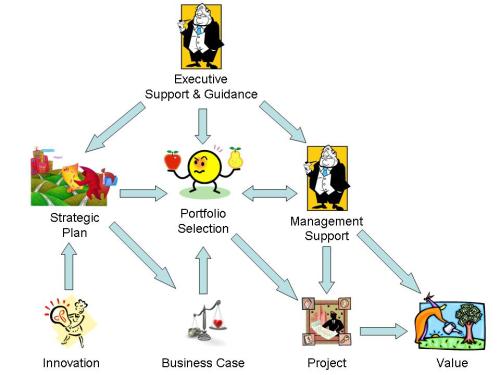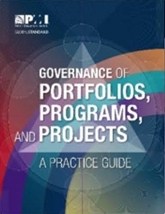Projects struggling for management support are one of the key indicators of a sub-standard value creation system that is failing to make full use of the deliverables created by projects and programs. But the problem is likely to be much deeper; surveys consistently show that between 15% and 80% of projects undertaken by organisations cannot be linked to the performing organisations strategy. These ‘ferrel projects’ are either symptoms of inadequate governance, or symptoms of inadequate strategic planning!
In many organisations, and particularly in business areas focused on system support such as IT the typical path taken by an innovative idea through to some confused delivery of value is a straight line from the innovation, to a business case, to a project that has to seek management support and the surviving projects eventually deliver their outputs to a bunch on unprepared and unwilling end users. The generation of value is far from certain!

Over the last few years, Portfolio Management has started to emerge. Portfolio management should have a strategic focus and make selections based on strategic priorities but in most current implementations tends to be a process oriented, stand alone function. Certainly by applying capacity constraints the number of projects that fail due to lack of organisational resources will be reduced but the focus on value creation is minimal. Management support and organisational change are not central to the process. There is literally a ‘fence’ between the executive ‘strategic planning’ processes and innovation within the organisation.

Most authorities describe project and programs as the ‘change agent’ responsible for creating the ability to implement strategic initiatives to grow and improve the organisation. For this to occur, the strategic planning system needs to be far more engaged with the organisation and central to the process of innovation, guided and supported by the organisations executive!

Within a value driven framework, the strategic planning process should be central to innovation, initiating work to develop prospective ideas, and receiving all of the innovative ideas to enhance the organisation from every source. Innovative organisations such as Google actively encourage innovation and experimentation within parameters but have careful selection processes before burning money on significant projects. They are also prepared use the innovative ideas to inform strategy, and to take significant strategic risks if an innovation warrants the speculation on a ‘whole new future’ for the organisation.
Within this framework, the evolution of the strategic plan is a cyclical process, possibilities and ‘blue sky’ ideas are communicated to the governing body, who formulate, review and update the overall strategic guidelines as new ideas and possibilities emerge.
However, my feeling is there is a tactical level missing from strategic thinking that will be needed for this process to work effectively. The overarching ‘strategic guidance’ needs to be fairly stable and take a long view and only be updated as needed (possibly twice a year). Based on this strategic guidance, a detailed strategic plan is developed at a ‘tactical level’, to frame the current implementation of the strategy. This process needs more rigour and more flexibility (the two are not mutually exclusive) compared to the high level plan, should only take a medium term view and be updated continuously. Based on this plan, feasible ideas that support the strategy are authorised for the development of a value oriented business case.
The creation of this flexible but rigorous tactical-level strategic process would place the ‘plan’ at the forefront of processes such as Portfolio Management and virtually eliminate ferrel projects.
Portfolio management also has a central role to play in developing strategy. The current strategy informs the portfolio selection process, and information on current projects and programs, the viability of assessed business cases and other consolidated information is absorbed back into the strategic planning process. Based on these factors, the key job of the portfolio managers is to select the most strategically important business cases, within the capability and capacity limitations of the organisation, for initiation as projects or programs, and cancel or modify projects that no longer align with the evolving strategic plan.
The role of management is firstly to implement the executive guidance by supporting the Portfolio Management processes and the selected projects. More importantly, management is also responsible for managing the organisation so that the necessary change initiatives are implemented to make effective use of the project deliverables to generate valuable returns over the life of the initiative, frequently a period of many years!
Developing a value driven system similar to the one described in this post is primarily a governance issue. The organisations directors and executives need to lead the process and be closely involved in the strategic management of the organisation.
Strategic planning also needs to evolve from a fluffy ‘high level’ process to a far more useful function that actually sets the strategy for the organisation’s management to implement. Within this framework, the organisations governance systems and leadership need to ensure their management support the process and are focused on creating value.

The Value Chain
However, the value creation chain is only as strong as its weakest link, which includes effective strategic planning supported by effective governance that ensures management support for the overall process. A clear indication the strategic governance processes are not working is when projects and programs have to fight to receive executive support to ‘exist’ and the organisation’s measure of success is limited to the ‘iron triangle’ of time, cost and scope focused at the end of the project.
Successful organisations focus on the more difficult, but more important measures of benefits realised and the value created for the organisation as a result of the project deliverables being used by the organisation to support its strategic initiatives and generate lasting improvements.
Most of the work needed to make this process work is in management areas outside of the traditional Portfolio, Program and Project management (PPP) arena. But no organisation will achieve the optimum results from its PPP initiatives without the front and back ends of the overall value chain being of equal ‘strength’.
This is not rocket science, many successful organisations, particularly in mining and engineering achieve this type of integration in their core business. For more on the governance aspects see: Mosaic WP1073 – Project Governance.
For more on the overall project delivery capability see: Mosaic WP1079 – Project Delivery Capability.
 One size does not fit every situation even in an agile world! The focus of this new article is to identify the differences in management approach needed to maximize value in three different situations where an ‘Agile’ approach can be used.
One size does not fit every situation even in an agile world! The focus of this new article is to identify the differences in management approach needed to maximize value in three different situations where an ‘Agile’ approach can be used.












